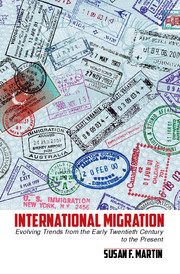Book contents
- Frontmatter
- Contents
- Foreword
- Acknowledgments
- List of Acronyms
- Introduction
- 1 Early Roots
- 2 “The Problem of Refugees”
- 3 Labor Mobility
- 4 Orderly and Humane Migration Management
- 5 Trafficking in Persons
- 6 Migration and International Security
- 7 Migration, the Environment, and Climate Change*
- 8 Migration and Development
- 9 Towards the Future
- Bibliography
- Index
3 - Labor Mobility
Published online by Cambridge University Press: 05 August 2014
- Frontmatter
- Contents
- Foreword
- Acknowledgments
- List of Acronyms
- Introduction
- 1 Early Roots
- 2 “The Problem of Refugees”
- 3 Labor Mobility
- 4 Orderly and Humane Migration Management
- 5 Trafficking in Persons
- 6 Migration and International Security
- 7 Migration, the Environment, and Climate Change*
- 8 Migration and Development
- 9 Towards the Future
- Bibliography
- Index
Summary
There are good reasons to believe that international labor migration will be a defining issue of the twenty-first century. Most of the more than 230 million people who live outside of their home countries fit the labor migration category. International labor migrants come from all parts of the world and they go to all parts of the world. In fact, few countries are unaffected by such movements. Many countries are sources of international labor flows, while others are net receivers, and still others are transit countries through which migrants seeking work reach receiving countries.
As discussed in the Introduction, it is highly likely that international labor migration will increase still further in the future, due to demographic, economic, and security trends. Migration occurs when there are economic disparities between source and receiving countries, and when individuals have the capacity to move from poorer and less secure places to wealthier and more secure countries with greater economic opportunities. These disparities are increasing, particularly with the demographic trends toward an aging developed world and a still-growing developing one. At the same time, globalization gives more people the knowledge and resources needed to find work in other countries.
- Type
- Chapter
- Information
- International MigrationEvolving Trends from the Early Twentieth Century to the Present, pp. 93 - 123Publisher: Cambridge University PressPrint publication year: 2014

